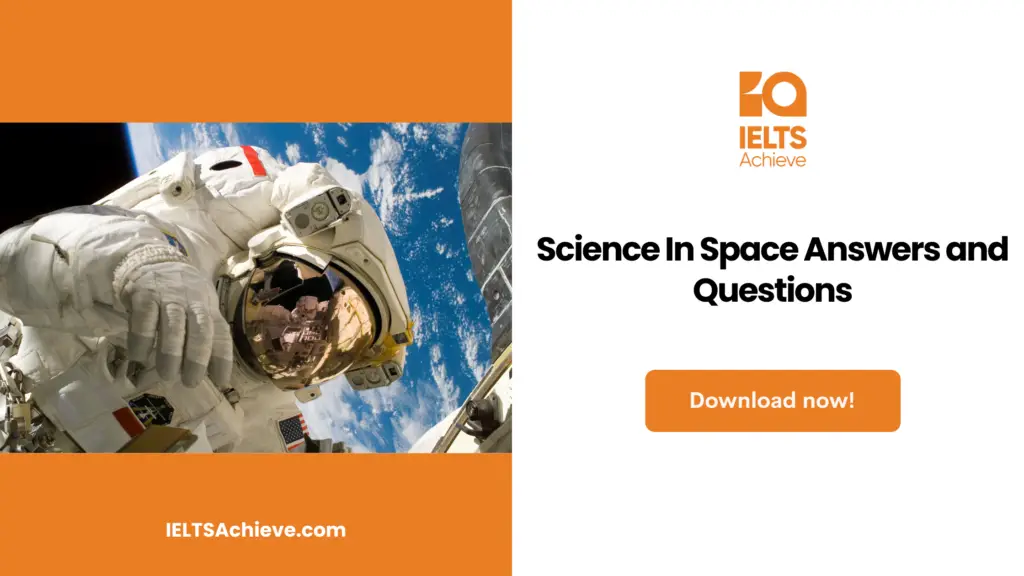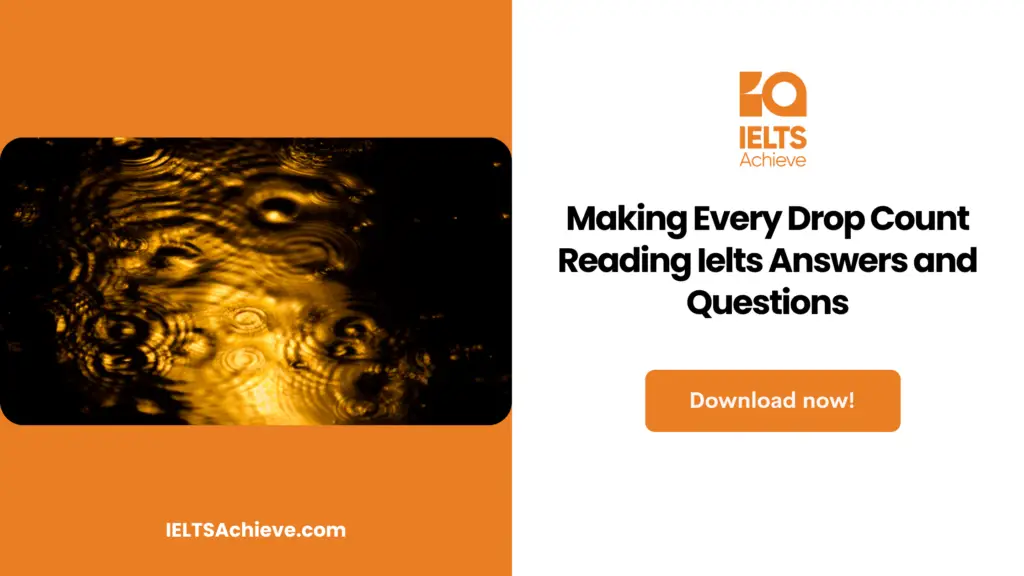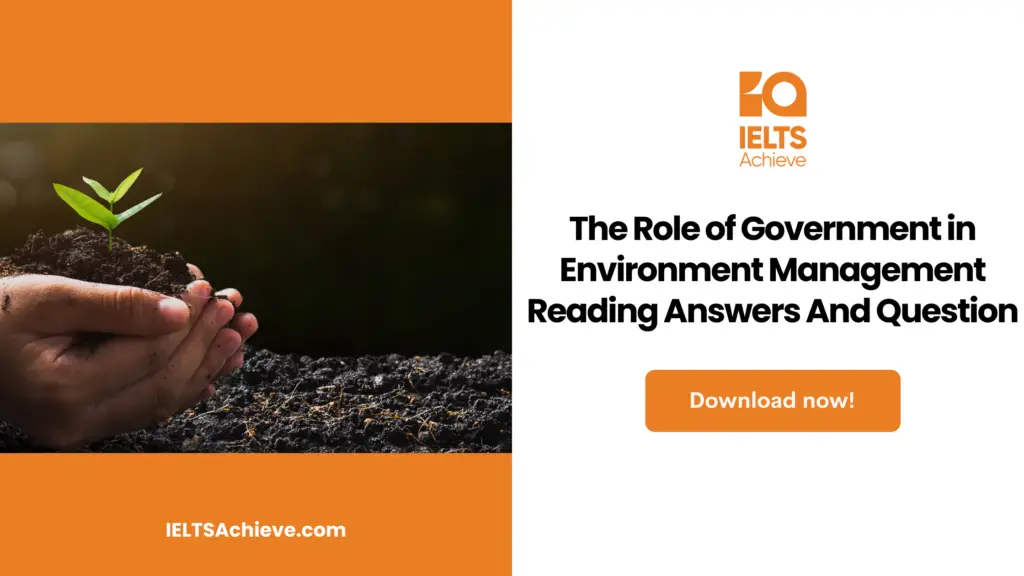The Blog post contains the following IELTS Reading Questions:
- IELTS reading multiple choice questions
- IELTS reading matching features
- IELTS reading summary completion
Stay informed and prepared for success – Explore our comprehensive Reading Test Info page to get valuable insights, exam format details, and expert tips for mastering the IELTS Reading section.
IELTS Reading Passage: Science in Space

Science in Space
A. A top-notch, top-notch laboratory in low-Earth orbit. In 2001, the US Congress was persuaded to approve the construction of the International Space Station (ISS) by the National Aeronautics and Space Administration agency (NASA). No one today questions the agency’s technological aspirations. The largest collection of interconnected modules ever built orbits the planet at a speed of more than 27,000 km/h thanks to the most difficult engineering feat ever attempted. Critics claim that while it may be moving quickly, as a lab it is standing still. It has spent $150 billion so far.
B. So what should be its top priorities moving forward? The first annual ISS research and development conference, which recently took place in Colorado, addressed this issue. One of the speakers was Satoshi Iwase of the Japanese university Aichi Medical, who has spent years developing an experiment that may help address one of the major issues that spaceflight will present for humans: maintaining physical health. Physiologists have discovered that, in the absence of gravity, our bodies start to deteriorate, leaving astronauts with frail bones, muscles, and cardiovascular systems. Astronauts will almost certainly need to create their own artificial gravity to counteract these effects on a long-duration mission to, say, Mars. Iwase steps in at this point. He is the team leader creating a centrifuge for people. An astronaut is fastened into the seat of a device that resembles an exercise bike in its initial design. While exercising while experiencing artificial gravity, pedaling works the astronaut’s muscles and cardiovascular system. It also causes the seat to rotate vertically around a central axis.
C. The project to build a centrifuge demonstrates the station’s potential as a research lab. Similar devices have been carried into space by NASA’s shuttles, but they couldn’t be tested for an extended period of time to determine their efficacy. Astronauts would need to ride in a centrifuge for 30 minutes a day for at least two months to adequately evaluate how it affects human physiology, according to calculations. The only way to test this is in zero gravity, and the only place we can do that is on the space station, claims Laurence Young, a Massachusetts Institute of Technology expert in space medicine.
D. There are undoubtedly many options for new experiments, but not all of them have taken off. The crew of the space station won’t be able to spin the centrifuge until another five years have passed, even if the project is approved. According to a US National Academy of Sciences report from April 2011, lengthy delays like this are one of NASA’s main challenges. The report’s authors expressed their “deep concern” about the state of NASA’s scientific research and offered a number of suggestions. The agency was advised to establish clearer research priorities in addition to shortening the time between experiment approval and launch.
E. By hiring management consultants ProOrbis to create a strategy to get around the red tape, NASA has already started to act. Additionally, Congress instructed NASA to work with the Centre for the Advancement of Science in Space (CASIS), a private company, to help oversee the US lab facilities on the station. One of CASIS’s responsibilities is to persuade public and private investors that science on the station is worthwhile investing in, as the ISS certainly appears to be a poor value when measured solely by the number of papers published; since 1998, station research has produced about 3,100 papers. In contrast, the Hubble Space Telescope has generated more than 1,300 papers in a little more than 20 years while costing less than a tenth of the price of the space station.
F. However, Mark Uhran, the ISS’s assistant associate administrator, disputes the claim that the station hasn’t conducted any worthwhile research. He cites achievements, such as those made with the salmonella vaccine. CASIS has looked at more than 100 prior microgravity experiments to find promising research themes to put the ISS research back on track. It has chosen to concentrate on life science and medical research as a result, and it recently requested proposals for studies on the immune system, osteoporosis, and muscle atrophy. The organization further asserts that the ISS should be used to test products that are either about to hit the market or have already done so as well as to develop products with commercial applications. According to Uhran, attracting investment from outside organizations is essential, and a balance between academic and commercial research will facilitate this.
G. Even though the station needs to draw cutting-edge research, many scientists appear to be unaware of what takes place there. More than 200 interviews with individuals from organizations that might be interested in low-gravity studies were conducted by Jeanne DiFrancesco at ProOrbis. Some people were aware of the ISS but were unaware of what was happening there, according to her. Others are aware of science, but they are unsure of what kind it is.
H. The privately funded space flight industry may provide the ISS with its biggest public relations boost, according to planetary scientist Alan Stern. Given that it can slash launch costs by two-thirds, businesses like SpaceX could support NASA and its partners in their efforts to resupply the International Space Station. The high-altitude balloon from Zero2lnfinity or Virgin Atlantic’s Spaceship Two may also help the space station’s prospects. Even though they won’t be in the same orbit as the ISS, Stern thinks they will fundamentally alter how the general public views space. He predicts that soon everyone will be daydreaming about visiting other planets once more. The fact that scientists are already waiting in line for seats on these low-gravity spaceflight services is more important because they want to use the time in weightlessness to gather data. This demand for inexpensive space travel could eventually result in a service that operates more frequently, allowing researchers to test their hypotheses before submitting a proposal for experiments on the ISS. According to Stern, gaining flight experience should help them land a spot at the station.
Unlock your full potential in the IELTS Reading section – Visit our IELTS Reading Practice Question Answer page now!
Recommended Questions:
Renewable Energy IELTS Reading Question with Answer
IELTS Reading Questions: Science in Space
Questions 1-4
Choose the correct letter, A, B, C, or D.
1. The author makes use of the Hubble Space Telescope to
A. justify how long it takes a space project to yield results
B. Describe the types of projects that are more likely to be funded
C. underline the significance of ISS positive promotion
D. cite the reasons behind the drop in space technology investment
2. The sixth paragraph informs us that CASIS has
A. invited scientists to recommend specific health-related initiatives
B. questioned the value of some of the ISS’s ongoing projects
C. expressed worry over testing goods that are sold for profit
D. rejected a few requests for ISS experimentation
3. What does the author say in the opening paragraph about the ISS?
A. NASA ought to have been more specific in its mission statement
B. The speed it has attained has been questioned
C. It is an excellent illustration of technological innovation
D. The cost of manufacturing stayed within the allocated amount
4. What is known about the experimental device created by Satoshi Iwase?
A. Iwase had no idea that it would have advantages
B. It is only intended to function in environments with little gravity
C. Originally, NASA had ordered it
D. It is based on common exercise apparatus
Ready to improve your performance in Multiple Choice Questions (MCQs)? Click here to access our comprehensive guide on how to tackle MCQs effectively in the IELTS Reading section.
Questions 5-9
Look at the following opinions (Questions 5-9) and the list of people below. Match each opinion with the correct person, A, B, C, or D.
NB You may use any letter more than once.
5. It is necessary to expedite the process of adding approved projects to the ISS.
6. There needs to be no gravity for new space technology to be evaluated properly.
7. The ISS should be accessible for commercial endeavors.
8. Some of the ISS’s accomplishments are overlooked.
9. What kinds of projects are feasible on the ISS are generally unknown.
List of people
- Mark Uhran
- Jeanne Di Francesco
- Laurence Young
- Authors of the US National Academy of Sciences report
Improve your performance in Matching Features questions by clicking here to access our comprehensive guide. Learn how to match specific features or characteristics with the options provided in the IELTS Reading section.
Questions 10-13
Complete the summary using the lists of words, A-H, below.
The influence of commercial space flight on the ISS
He thinks they could alter public perception for two reasons: first, using a commercial craft would 10. _______________ the cost of sending supplies there; second, it might make space exploration seem 11. _______________ appealing to the general public. Another consideration is that there is a chance that space flights will become more 12. __________ as demand rises. Additionally, by focusing on a commercial flight first, researchers would be 13. _____________ if an ISS position opened up.
- Suitable
- Rapid
- Economical
- Regular
- Competitive
- Real
- Safe
- Flexible
Boost your performance in Summary, Notes, Table, and Flowchart Completion tasks. Click here to explore our detailed guide and learn how to effectively complete summaries, notes, tables, and flowcharts in the IELTS Reading section.
Questions 14
Choose appropriate options A, B, C, or D.
14. In Writing this article, the author hopes to
A. Compare worthwhile and useless space projects
B. criticize the ISS for having a closed mind
C. show how the ISS could be made more efficient
D. promote the general benefits of space travel
Ready to improve your performance in Multiple Choice Questions (MCQs)? Click here to access our comprehensive guide on how to tackle MCQs effectively in the IELTS Reading section.
Unlock your full potential in the IELTS Reading section – Visit our IELTS Reading Practice Question Answer page now!
Recommended Questions:
Renewable Energy IELTS Reading Question with Answer
Science in Space reading answers
1. C
2. A
3. C
4. D
5. D
6. C
7. A
8. A
9. B
10. C
11. F
12. D
13. A
14. C

We hope you found this post useful in helping you to study for the IELTS Test. If you have any questions please let us know in the comments below or on the Facebook page.
The best way to keep up to date with posts like this is to like us on Facebook, then follow us on Instagram and Pinterest. If you need help preparing for the IELTS Test, join the IELTS Achieve Academy and see how we can assist you to achieve your desired band score. We offer an essay correction service, mock exams and online courses.

